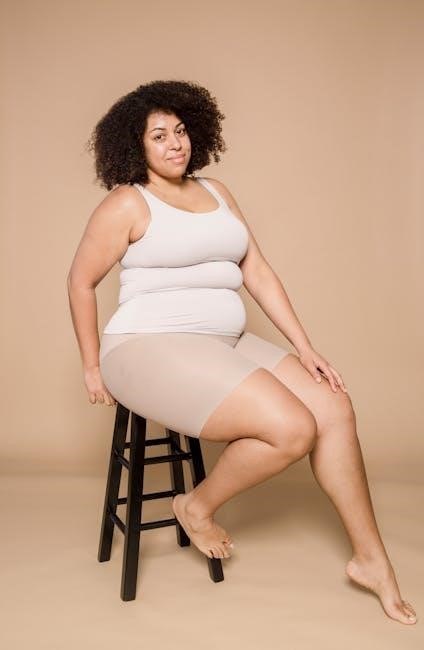Understanding T-shirt sizing ensures a comfortable and flattering fit. Measurements like chest width, sleeve length, and shirt length are crucial. Styles vary, and fabric type impacts fit, making size guides essential for accurate choices.
Understanding T-Shirt Measurements
Accurate measurements are essential for determining the right T-shirt size. Key measurements include chest width, sleeve length, and shirt length. Chest width is measured around the fullest part of the chest, keeping the tape horizontal. Sleeve length is measured from the center back of the neck to the wrist. Shirt length is measured from the top of the shoulder to the bottom hem. Fabric type and stretch also influence fit, with some materials offering more flexibility. Using a size chart and comparing measurements to a well-fitting T-shirt can help ensure the best fit. Always consider style variations, as they may affect sizing.
Importance of Proper Fit
A proper fit is crucial for both comfort and style. A well-fitting T-shirt enhances confidence and ensures a polished look. It allows for a full range of motion while maintaining a flattering silhouette. Ill-fitting shirts, whether too tight or too loose, can be unflattering and uncomfortable. Proper fit also extends the life of the garment, as it prevents stretching or sagging. Considering factors like fabric type and personal style helps in selecting the right size. Using a size chart and measuring accurately ensures the best fit, making the T-shirt a versatile and essential wardrobe piece for any occasion.

Key Measurements for T-Shirt Sizing
Chest width, sleeve length, shoulder width, and shirt length are essential measurements for determining T-shirt size, ensuring proper fit and desired style.
Chest Width Measurement
Chest width is a critical measurement for determining T-shirt size, reflecting the garment’s fit across the torso. It is measured around the fullest part of the chest, keeping the tape measure horizontal and parallel to the floor. This measurement ensures the T-shirt will neither be too tight nor too loose, providing comfort and a flattering appearance. Proper alignment with size charts helps match your chest circumference to the appropriate size. Fabric stretch and style can influence how measurements translate to fit, so considering these factors is essential. Always measure accurately to ensure the best fit, as chest width is the primary determinant of T-shirt sizing.
Sleeve Length and Shoulder Width
Sleeve length and shoulder width are key measurements for ensuring a balanced and comfortable T-shirt fit. Sleeve length is typically measured from the center back of the neck to the wrist, varying slightly by style. Shoulder width is measured across the top of the shoulders, ensuring the T-shirt sits properly without being too tight or sloppy; These measurements, combined with chest width, create a harmonious fit that complements the body’s proportions. Accurate sleeve and shoulder measurements are essential for both style and comfort, ensuring the T-shirt drapes naturally and moves freely with the body. Proper alignment with size charts guarantees a flattering and functional fit.
Shirt Length and Body Fit
Shirt length and body fit are critical for comfort and style. T-shirt length varies by style, with regular-fit shirts typically measuring 27-30 inches (69-76 cm) from the center back. Tall styles are slightly longer, while oversize shirts extend beyond for a relaxed look. Body fit ranges from slim, regular, and loose, each catering to different preferences. Slim-fit shirts hug the body closely, while loose fits offer a relaxed drape. Shirt length should align with body proportions, ensuring the hem falls appropriately relative to waist and hips; Proper fit enhances both comfort and aesthetic appeal, making it essential to consider these measurements when choosing a size.

How to Measure Yourself for the Perfect Fit
Measuring yourself accurately ensures the best fit. Chest circumference, sleeve length, and shirt length are key. Use a flexible tape measure and compare with size charts for accuracy.
Measuring Chest Circumference
To measure chest circumference, wrap a flexible tape measure around the fullest part of your chest, keeping it horizontal and parallel to the floor. Ensure the tape is snug but not tight, with the measure placed just under your arms. This measurement is crucial for determining your T-shirt size, as it directly corresponds to the chest width in size charts; For accurate results, stand up straight and avoid slouching. If the measurement falls between sizes, consider the fit style—slim-fit shirts may require sizing up for comfort. Always refer to the specific size chart provided by the brand, as measurements can vary slightly between styles and fabrics.
Measuring Sleeve Length
To measure sleeve length accurately, start at the center back of your neck, just below the base. Place the tape measure over your shoulder, following the natural curve of your arm to the wrist. Keep your arm slightly bent for a comfortable fit. This measurement helps determine the sleeve length of your T-shirt. Compare it to the brand’s size chart, as styles like slim-fit or tall may have different proportions; Ensure the tape is not too tight or loose. Sleeve length varies by style, so always check the specific measurements provided by the brand to ensure the perfect fit for your body type and desired look.
Measuring Shirt Length
To measure shirt length accurately, start at the top of your shoulder, just below the neckline. Place the tape measure straight down to the desired hemline, typically at the hip or mid-thigh depending on the style. Keep the tape measure level and not too tight. This measurement ensures the T-shirt falls at the right point on your body. For the best fit, consider your personal preference for length, whether it’s cropped, standard, or longer; Compare your measurement to the brand’s size chart, as shirt length can vary by style, such as slim-fit or tall fits. Always double-check the measurements to ensure comfort and style alignment.
Factors Influencing T-Shirt Fit
Fabric type, stretch, and style significantly impact T-shirt fit. Different materials drape uniquely, while styles like slim or loose cuts alter comfort and appearance, affecting overall sizing accuracy.
Fabric Type and Stretch
Fabric type and stretch play a crucial role in T-shirt fit. Materials like cotton, polyester, or blends vary in stretch and comfort. Cotton offers breathability, while polyester blends provide durability. Stretch fabrics, such as spandex mixes, enhance flexibility. The fabric’s weave and weight also affect how it drapes on the body. For instance, tri-blend fabrics combine softness with a vintage feel. Understanding fabric types helps in selecting a T-shirt that meets comfort and style needs. Always consider fabric characteristics to ensure the best fit and comfort for different occasions or activities.
Style and Design
T-shirt styles and designs significantly impact fit preferences. Classic styles offer a timeless look, while slim-fit designs provide a more tailored appearance. Graphic tees may have varying lengths and widths due to print placement. Crew necks and V-necks differ slightly in measurements, affecting how they sit on the body. Some designs, like tall or longline tees, cater to specific body types or fashion trends. Understanding your style preferences helps in choosing the right size and fit. Always consider design elements when selecting a T-shirt to ensure it aligns with your desired look and comfort level.

Size Charts and Comparisons
Size charts provide detailed measurements for each size, enabling accurate comparisons. Standard and slim-fit options cater to different body types. International comparisons help find the right fit globally, as sizing varies by region and brand.
Standard vs. Slim Fit
Standard fit T-shirts offer a classic, relaxed silhouette, suitable for most body types. They provide comfort and ease, often preferred for casual wear. Slim fit T-shirts, however, are tailored closer to the body, accentuating a more modern and streamlined look. They are ideal for those who prefer a fashionable, form-fitting style without being overly tight. The key difference lies in chest width and sleeve length, with slim fit shirts having narrower measurements. Both styles cater to different preferences, ensuring the right balance between comfort and aesthetics. Understanding these distinctions helps in choosing the perfect T-shirt for any occasion. Measurements vary slightly between brands, so checking size charts is essential for the best fit.
International Size Comparisons
International T-shirt sizing varies significantly across regions, making it essential to refer to size charts. For instance, a Medium in the US may equate to a Large in Europe or Australia. Chest measurements are a key factor, with sizes labeled differently worldwide. For example, an XS in Italy might align with an S in the UK. These discrepancies can cause confusion, so comparing measurements is crucial. Many brands provide international size conversions to help customers choose the right fit. Always check the specific size guide for accurate sizing, as global standards differ widely. This ensures a comfortable and well-fitting T-shirt regardless of the region.

Material Impact on Fit
Fabric type significantly affects T-shirt fit. Cotton offers breathability, polyester durability, while blends provide stretch. Bamboo and tri-blend fabrics add unique textures and comfort, influencing overall wearability;
Different Fabrics and Their Effects
Different fabrics significantly impact the fit and comfort of a T-shirt. Cotton is breathable and soft, ideal for casual wear, but may shrink after washing. Polyester offers durability and moisture-wicking properties, making it suitable for athletic use, though it can feel less soft. Blends, like cotton-polyester, combine breathability with durability, offering a balanced fit. Bamboo fabrics are eco-friendly, moisture-wicking, and naturally antibacterial, providing a luxurious feel. Tri-blend fabrics, often used for vintage styles, offer a soft, lightweight texture with a bit of stretch. Fabric choice can influence sizing, as some materials have more stretch or shrinkage, affecting how they fit over time.
Selecting the right T-shirt size involves understanding measurements, fabric types, and personal style. Proper fit enhances comfort and appearance, while considering factors like shrinkage and fabric stretch ensures long-term satisfaction. By using size guides and measuring accurately, you can make informed choices. Remember, different brands may vary slightly, so always check their specific charts. Investing time in finding the perfect fit guarantees a wardrobe staple that feels great and looks timeless. Whether for casual wear or specific activities, the right size ensures optimal comfort and confidence. Make sizing a priority to enjoy your T-shirts fully, knowing they meet your needs and preferences perfectly.
